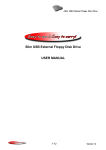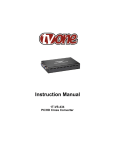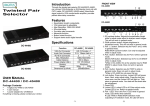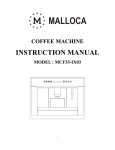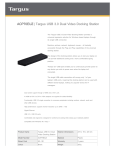Download Owner`s Manual - Musik Produktiv
Transcript
SAFETY PRECAUTIONS: • Read these instructions. • Keep these instructions. • Heed all warnings. • Follow all instructions. Congratulations on your choice of MESA/Boogie and welcome to the MESA Family! The same passion for excellence, commitment to quality and dedication to customer satisfaction is present in each and every product we make in our one- and-only shop in Petaluma, California, U.S.A. Rest assured that the very same people that hand-build the finest amplifiers in the world built your pedal and you have access to the same resources for help that all our customers do. Call on us anytime and enjoy! • Do not use this apparatus near water. • Clean only with dry cloth. • Be sure to use only properly rated power adaptors or universal power supplies (pedal board power supplies) with appropriate attention paid to proper voltage, amperage and ground schemes. Improper voltage/amperage being provided to the pedal may cause poor tone, inconsistent performance, damage to the unit, or all of the above. Proper voltage, amperage and grounding specs are supplied at the end of this manual. Owner’s Manual • REPLACE THE BOTTOM LID after battery replacement before the unit is used. Some electronic parts inside are static sensitive and can be damaged from even a small static charge from contact with carpet or other conductive surfaces. DO NOT SET A POWERED UNIT “CONTROLS UP” ON A METAL (or any) SURFACE WITH THE BOTTOM REMOVED! There is also enough gain available in the LEVEL control to use the GRID SLAMMER as an “input slamming device” to introduce a hotter signal to the INPUT stage of your amplifier – hence the name. In this scheme you clip the amplifier’s first stage with a greater amplitude signal (instead of adding preamp gain) to achieve an overdrive with a different character. You may find this sound “more vintage” in nature – though you might also find that you have a little less control over color and harmonic/dynamic content than you would using the GRID SLAMMER’s GAIN control to create the overdrive. GRID SLAMMER™ The GRID SLAMMER is an Overdrive pedal that produces a variable boost in gain over a wide range with a classic 70s midrange bump for enhancement of many different styles. If you are looking for minimal saturation or more of a “clean boost” to push Clean sounds with just a subtle gain increase, try our TONE BURST™ pedal. If you are looking for an Overdrive device with more control over low and high frequencies individually, try our FLUX-DRIVE™ pedal. For the highest gain applications, check out our THROTTLEBOX™ distortion pedal. Overdrive begins with the GRID SLAMMER in the low region of the GAIN control with a soft clip, transitions through medium gain and tops out at the lower-end of “High Gain”, still with substantial saturation of the notes. In the lower region, the additional midrange boost adds attack and percussiveness to the character of your instrument and here is where some classic pushed rhythm or Blues solo sounds reside. As the GAIN control is increased beyond the 12:00 range, this midrange bump is softened and a creamier, legato personality emerges that is great for singing lead lines where a more vocal quality is desired. FEATURES & CONTROLS IN: This ¼” phono jack is the Instrument Input for the device. Plug the Output of your guitar into this jack with a shielded cable of good quality. The jack is a switching type jack and the circuit is turned on when a cable is inserted. When the circuit is activated by inserting a cable, the internal battery is being used to power it – so be sure to unplug the cable from the INPUT when it’s not in use. NOTE: The internal battery is switched to an “ON” state (drawing voltage) by a switching element in the INPUT jack. To prolong battery life, disconnect the cable from the ¼” INPUT jack whenever the unit is not in use. NOTE: If you wish to leave the INPUT connected permanently – as in a pedal board scenario – it is advisable to power the unit with an external 9V power supply. When an external (plug-in) AC 9-volt power supply is used to power the unit the DC Receptacle on the pedal automatically disconnects the battery to avoid battery wear and preserve its useful life. If you are going to use external AC power either for long periods or permanently in a pedal board set-up, remove the internal battery to prevent (forgotten) battery corrosion. OUT: This 1/4” phono jack is the OUTPUT for the device. Connect the OUTPUT to the Input of your amplifier (or the INPUT of the next device in line) with a shielded cable of good quality and of the shortest length possible. NOTE: A Word on Cables… Always use shielded instrument cables of the best quality and shortest length possible when connecting these types of devices. This will minimize degradation of your sound, particularly high frequency roll-off, due to the added capacitance in longer lengths of cable. We recommend no more than 18-20 feet total (Input and Output combined) between your instrument and the termination at the INPUT of the amplifier. If you must use longer cable lengths, you might consider the use of a Buffer or Line Driver to keep the tonal integrity intact. While these change the sound slightly, it will usually be preferable to top end roll-off. And yes – those little 4” interconnects count too, so count them in your cable length. GAIN: This control determines the amount of gain (distortion / overdrive) in the signal path. Set low (8:00 – 10:30) it produces a range of subtle overdrive that’s soft and furry, yet featuring the classic midpunch associated with these types of circuits. This range is great for pushed and clip-threshold rhythm sounds and to add a slight bump for Blues solo sounds. The middle range (10:30 – 1:30) offers the most useful region of gain that begins to saturate but still retains a dynamic punch that keeps notes expressive and tight. This works well for both Rhythm and Solo work across many styles of music. The high range of the GAIN control (1:30 – 5:30) is all about smooth saturation. This region is most suited for single note soloing with its softer attack and more liquid response. It also has some applications for big crunch chording, but is not as harmonically complex in the top end as some pedals that are dedicated to higher gain styles. TONE: This control is found on devices that do not incorporate individual TREBLE and BASS controls. It provides simple, global adjustment of the entire range of frequencies with one control – but your ear may perceive it as most active on the amount of high frequencies present in the mix. A setting of 12:00 represents a “flat” setting with highs neither boosted or cut. Increasing the TONE control past 12:00 boosts a broad band of high frequencies. Decreasing the TONE below 12:00 cuts (rolls off) the same spectrum of high frequencies. LEVEL: This is the master output level and it controls the amount of signal provided to the host amplifier. It can be used either to balance levels to compensate for high GAIN settings - so that no jump in level occurs when switched out of BYPASS. Another application is higher LEVEL settings to purposefully send a hotter signal to the host amp and “slam” the input stage for increased clip, drive or gain. AC POWER: This standard female DC Receptacle on the pedal is the External Power Supply Jack and it accepts the male plug from a standard 9-Volt “wall-wart” AC power supply. When installing your unit into a pedal board utilizing a universal power supply (multi-output pedal board power supplies), connect the external power source here. The internal battery is automatically disconnected by a switching element in the External DC Receptacle on the pedal. However, if you know you will not be using battery power for an extended period – for example, if you are mounting the unit to your pedal board permanently - it is wise to remove the battery to avoid possible damage from long-term battery corrosion. INTERNAL BATTERY: This unit can operate on either a 9-Volt battery or a standard 9-Volt “wall-wart” power supply. The unit is shipped from the Factory with a long-life 9-Volt Battery to facilitate easier trial demonstration in a music store environment. NOTE: The internal battery is switched to an “ON” state (drawing voltage) by a switching element in the INPUT jack. Disconnect the cable from the ¼” INPUT jack whenever the unit is not in use to prolong battery life. BATTERY REPLACEMENT: To access the 9-Volt battery for inspection, replacement or removal; make sure the External Power Jack is disconnected, remove the four Phillips-head screws from the four corners of the bottom lid and remove it. Note the orientation/direction of the battery and terminals and replace it in the same position. NOTE: Any type of 9-Volt battery will work in this device if it is fully charged and functional. Carbon Zinc, Alkaline or even Nickel Cadmium Rechargeable type batteries are all acceptable replacements. Some pedal aficionados prefer the “sweetness” they claim to hear from standard Carbon Zinc type batteries, but you will have to decide what type best serves your needs. SAMPLE SETTINGS: SUBTLE CLIP SAMPLE SETTINGS: USER SETTINGS: BLUES SOLO SPECIFICATIONS: • Dimensions (W/D/H): 2.87” x 4.77” x 2.28” (73mm x 122mm x 58mm) • Weight: 0.731lbs (332g) with battery, 0.631lbs (287g) without battery ® LEVEL TONE GAIN LEVEL TONE GAIN LEVEL TONE GAIN • True Bypass Switching • Battery Type: 9VDC (one) • Power Consumption (Current Draw): 9VDC/15mA • AC Adapter (Optional): Power Jack 2.1mm x 5.5mm, 9VDC with Negative Center (Regulated Recommended) SMOOTH SUSTAIN GRID SLAM ® • Input Impedance: 1M Ohm (500k Ohm minimum) • Output Impedance: 10k Ohm LEVEL TONE GAIN LEVEL TONE GAIN LEVEL TONE GAIN










